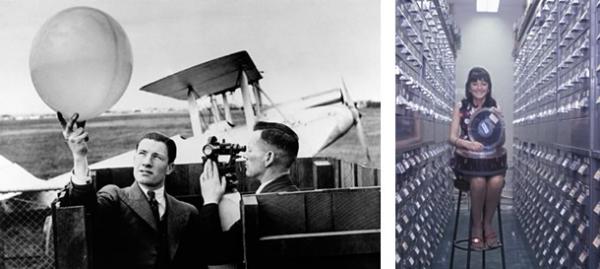A short history of the Bureau of Meteorology
24 August 2011
Australia's diverse and dynamic weather has captured the imagination of its inhabitants since time immemorial. But it was not until 1 January 1908, nearly 120 years after William Dawes built his famous observatory at Sydney Cove, that the country gained its first national weather agency: the Bureau of Meteorology.

Left: Bureau of Meteorology staff members J.S. Maher prepares to release a weather balloon as Jack Nance readies the theodolite to track the balloon flight at Essendon airport (Melbourne, March 1938). A Gipsy Moth aircraft is behind the observers. Photograph from the Bureau of Meteorology's image archive.
Right: Weather data stored on 30 million punch cards in National Climate Centre filing cabinets was moved on to magnetic computer tapes - as held by a Bureau of Meteorology staffer - in about1970. Photograph from the Bureau of Meteorology image archives.
Australia's diverse and dynamic weather has captured the imagination of its inhabitants since time immemorial. But it was not until 1 January 1908, nearly 120 years after William Dawes built his famous observatory at Sydney Cove, that the country gained its first national weather agency: the Bureau of Meteorology.
Our foundation and early years
The Bureau was created to consolidate the meteorological services of Australia's States which had developed extensive records of their regional weather during the 19th century. After complex negotiations, the Bureau was finally established in Melbourne through the Meteorology Act 1906. Amended in 1955, this Act and the Water Act 2007, form the Bureau's legal foundation.
Our early years saw steady scientific progress, with a small group of dedicated staff and thousands of volunteer 'weather watchers' establishing a robust data-collection network across the country. Gradually the early thermometer and rain gauge gave way to more sophisticated instruments. By the 1940s the first radiosonde stations began transmitting information from weather balloons. This gave Australian meteorologists an insight into the vital workings of the upper atmosphere.
The Bureau today
The Bureau has grown into a world-class agency providing much-needed environmental intelligence to the community and industry. We have a staff of 1,800, over 50 field offices across Australia and Antarctica, and a national network of 300 cooperative observers and 6,000 voluntary rainfall observers. We collaborate with the World Meteorological Organization and agencies in neighbouring countries on vital atmospheric and oceanographic monitoring activities, as well as early-warning systems for extreme weather events, tsunamis, volcanic ash clouds and more.
Since 2009, the Bureau has been under the directorship of Dr Greg Ayers, formerly Chief of Marine and Atmospheric Research at the Commonwealth Scientific and Industrial Research Organisation (CSIRO). Dr Ayers is the 9th Director at the Bureau in more than 100 years since its formation in 1908. During a distinguished 30-year career at CSIRO, he has served on numerous international committees and boards and wrote over 140 peer-reviewed papers. In 1995, Dr Ayers was awarded the Australian Meteorological and Oceanographic Society's Priestley Medal for achievements in the science of acid deposition.
Our mission
The Bureau's mission is to provide Australians with the information they need to live safely and sustainably within their natural environment, which encompasses the atmosphere, ocean, water and land. To achieve this, the Bureau of Meteorology:
- monitors and reports on current environmental conditions;
- analyses and explains trends in environmental data;
- provides forecasts, warnings and long-term outlooks on environmental phenomena that affect the safety and prosperity of Australians; and
- fosters greater public understanding of environmental intelligence.


Comment. Tell us what you think of this article.
Share. Tell others.